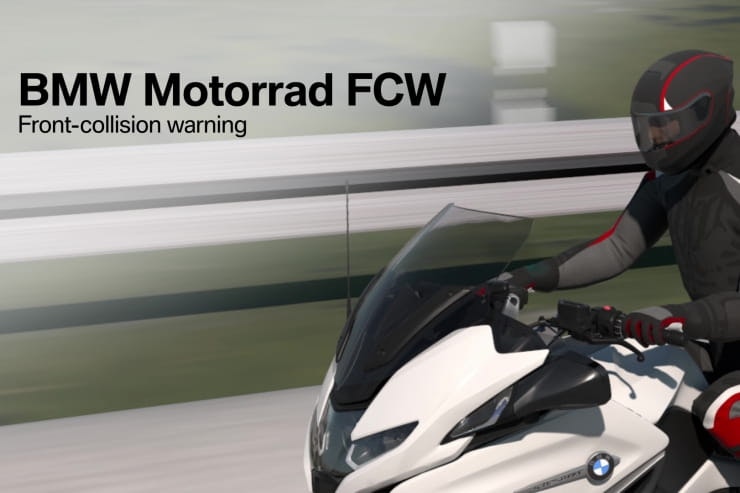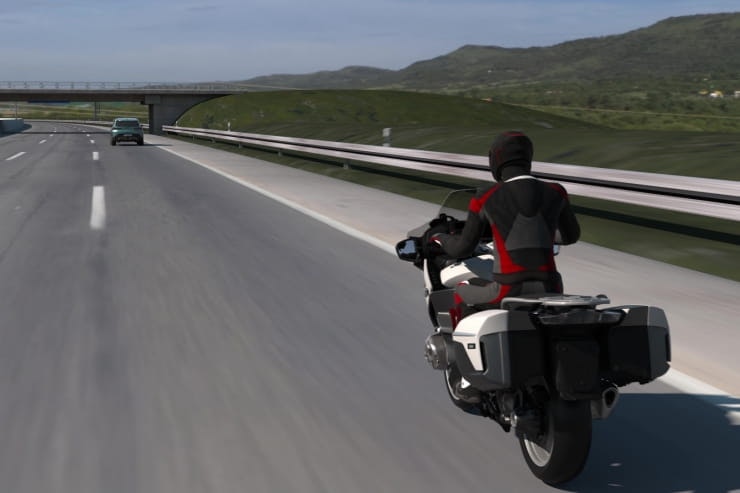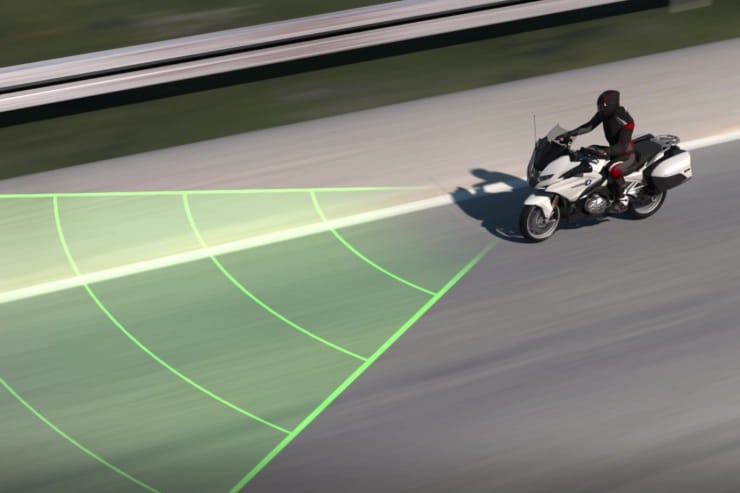There you are, cruising down the motorway late one warm summer afternoon, minding your own business. Today’s been a bit of a slog, but you’re almost at the end of several straight-line hours needed to reach the good stuff. Rush-hour traffic is slowly starting to build, but you’ve got some good tunes on the intercom and start thinking about the spectacular mountain passes you’ll be riding tomorrow. Ahead, a car stamps on its brakes. Thankfully, your bike has already identified the hazard in front. It’s warned you about it too, and is about to apply the brakes just enough to buy you a bit more reaction time so you can decide the best course of action. Sounds a bit too sci-fi to be true? In fact, this is the promise behind BMW’s brand-new front-collision warning system. And far from being the stuff of distant imagination, it’s coming to a road bike very soon – almost certainly the new BMW R1300GS.
What is BMW’s front collision warning system?
As with most motorcycle rider aids, it’s a bike-specific development of a technology that’s well established in the passenger car world. FCW follows in the footsteps of anti-lock brakes, traction control and active cruise control, all of which arrived on motorcycles 10 to 20 years after appearing in cars. Front collision warning systems began to appear on mainstream cars from around 2010 – so now it’s our turn.
So, how does a front collision warning work? A forward-facing radar sensor monitors the road ahead, identifies any vehicles in front, then their speed is compared to the bike’s. If the sums suggest that the bike is closing on the traffic ahead at such a rate that there could be a collision, the front collision warning is triggered.
One important note to clear up right from the start is that this is not a collision avoidance system – it’s not there to stop a crash from happening on its own. BMW say it’s an advanced assistance system that’s designed to help inform and support a rider, but responsibility for avoiding the accident still lies in our hands.
How does BMW’s front collision warning system work?
The system is designed to work at speeds between 30 and 160kph (about 20 to 100mph), so long as you are a) not using active cruise control, b) are in a riding mode where ABS is fully active such as Road, Rain or Dynamic (but not Enduro Pro), and c) have FCW activated in the menu.
With FCW running, the radar sensor at the front of the bike is then always active, keeping an eye on the traffic ahead and calculating your relative closing speed. If it detects a closing speed high enough to create a potentially critical situation, then the bike first gives the rider a ‘pre-warning’.
It begins with a visual alert – a small red car-shaped icon that lights up on the bike’s TFT display. However, BMW wants the system to alert a rider even if they’re not looking at the road ahead, and might not see the symbol. So next the bike gives a ‘haptic pulse’.
This is a physical alert that a rider feels through the bike, which comes from two quick pulses of brake pressure generated by the ABS pump. BMW say the pulse is brief enough that it won’t slow the bike down at all, and soft enough that it can’t possibly unsettle it or introduce instability. The idea is simply to catch the attention of a rider who may be, say, looking at the scenery, and bring their focus back to the road.
What happens if I ignore the warning?
If the rider doesn’t respond to the pre-warning and the front collision warning system notices the situation looking increasingly critical, next it moves to a more acute warning. The visual alert gets bigger – a much larger red car icon practically fills the entire TFT dash.
Then comes the clever bit: the bike gently applies the brakes for you. It won’t ever perform an emergency stop – the maximum deceleration it’ll generate on its own is limited to just 4.4m/s2, which is roughly half the rate a skilled rider can stop at. To be clear, the idea here isn’t for the bike to mash its brakes hard enough to bring you to a stop. BMW call it ‘braking support’, and the intent is to slow the bike just enough to give you more reaction time – it’s still up to you as the rider to decide whether to squeeze the brakes harder, or to perform an avoidance manoeuvre.
Won’t it give a load of false warnings in traffic?
BMW say no. They’re well aware that motorcycles deal with traffic very differently to cars – we’re more agile, we can filter, and can make safe passes in situations where cars can’t. And so their bike-specific system is set up differently as a result.
Perhaps the most curious feature of the whole system is something BMW calls a ‘rider attention estimator’, which is used to adjust the threshold before the system issues a warning. In short, because the bike can monitor every time the rider does anything on the bike – any time you push a button, change a setting in a menu, open the throttle, pull the clutch lever, squeeze a brake, change gear, increase lean angle – it can use this data to build a picture of whether you’re paying attention to the road ahead. If it thinks your attentiveness is high (if you’re riding ‘dynamically’, let’s say) the chances are your eyes are looking at the road ahead, and so it’ll set a later warning threshold. Conversely, if it sees inputs consistent with being distracted (fiddling in menus while not making any other input to the bike, for example), warnings will be flagged up earlier.
Can I turn the front collision warning off?
Yes, absolutely. BMW say you can switch the entire FCW system off in the menu if you prefer, and if you do it’ll stay deactivated even when you turn bike off and on again. Alternatively, if you aren’t keen on the haptic alert, you’ll be able to switch that element off while still keeping the rest of the front collision warning system active.
Which BMW bikes will have a front collision warning system?
At this stage, we don’t know for sure. All BMW will say for now is that it “will be coming in the near future”. However, it doesn’t take a genius to imagine that this front-collision warning system will be a key feature of the new R1300GS. The signs are all there: spy photos reveal a prominent radar sensor at the front of the bike; BMW will want to give their crucial new model some headline-grabbing new features; and their own admission that the system won’t work in Enduro Pro mode is also a fairly clear tell. However, we don’t know whether FCW will be included as standard, or an official option with an associated additional cost.
Over time FCW will no doubt spread across BMW’s range. The R1250RT tourer would be the next most likely candidate, as it’s the only existing model in the range with a radar – but BMW engineers say they can’t quickly or easily retrofit FCW to an existing model because the existing architecture isn’t up to it. In short, FCW requires decisions to be made inside a completely new central ECU, which the current RT doesn’t have. But an R1300RT might…
If you’d like to chat about this article or anything else biking related, join us and thousands of other riders at the Bennetts BikeSocial Facebook page.
Share on social media:


